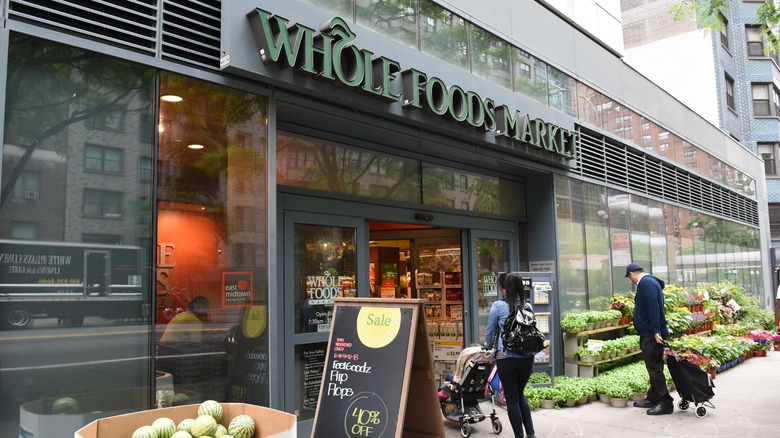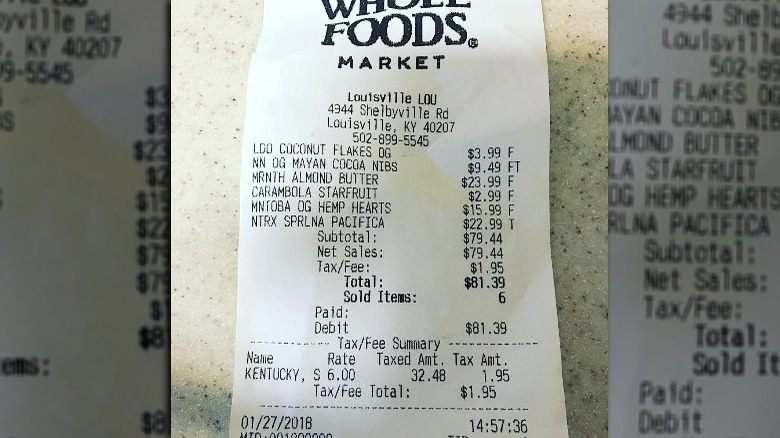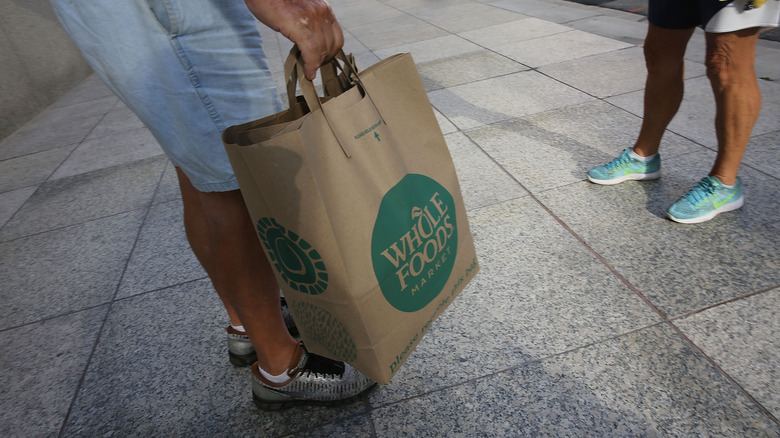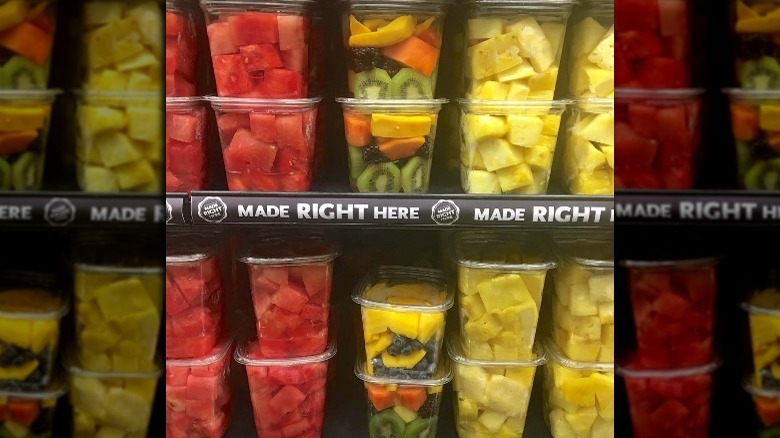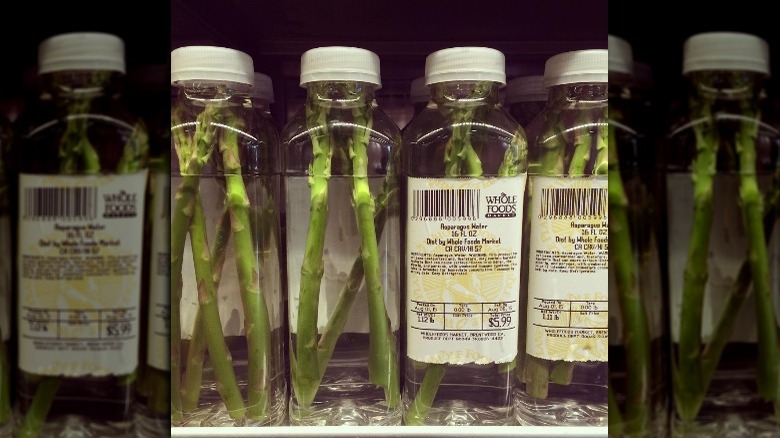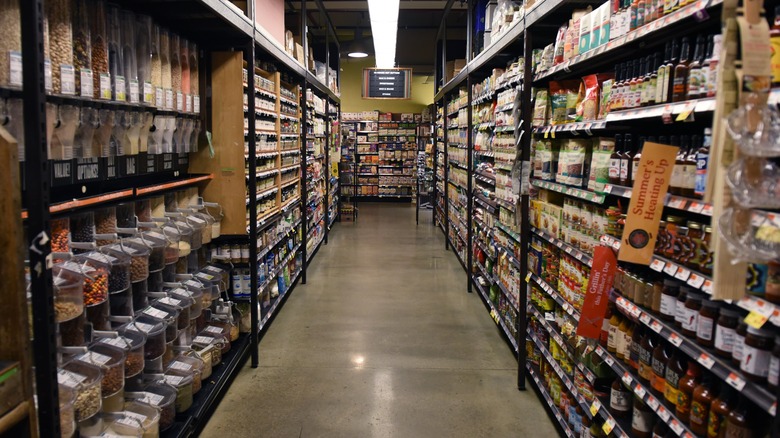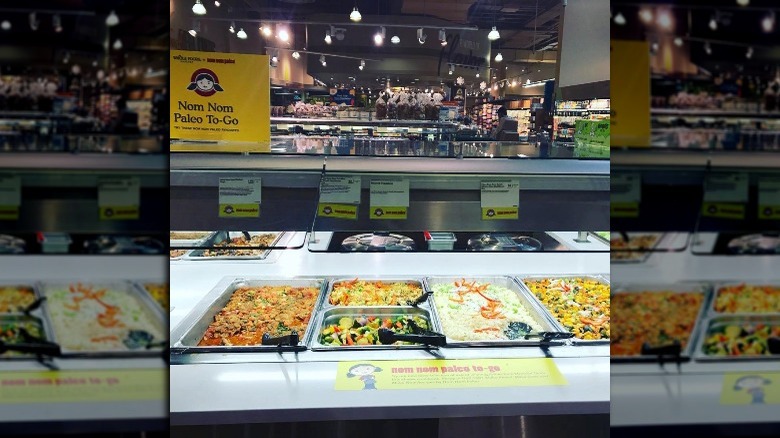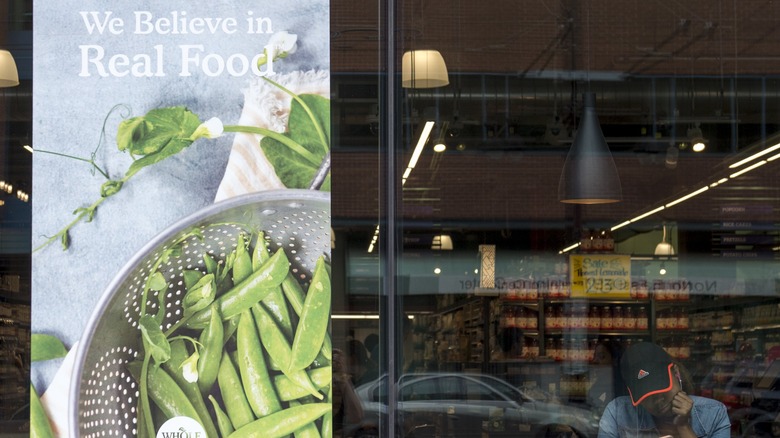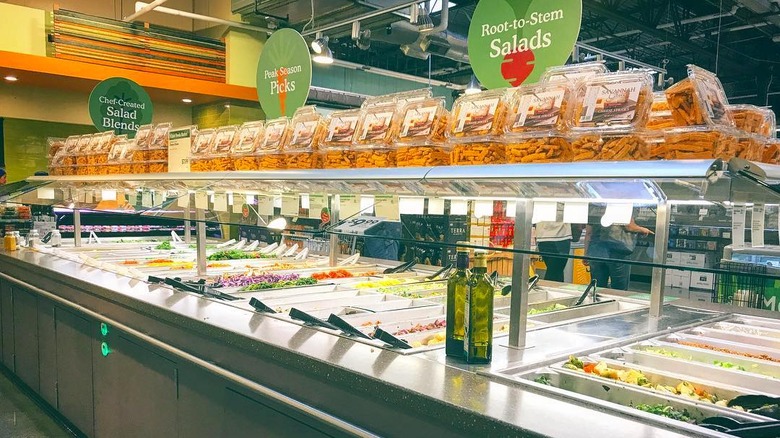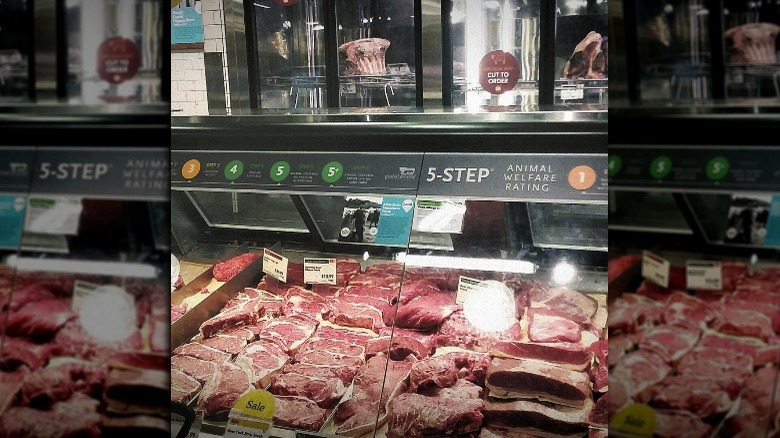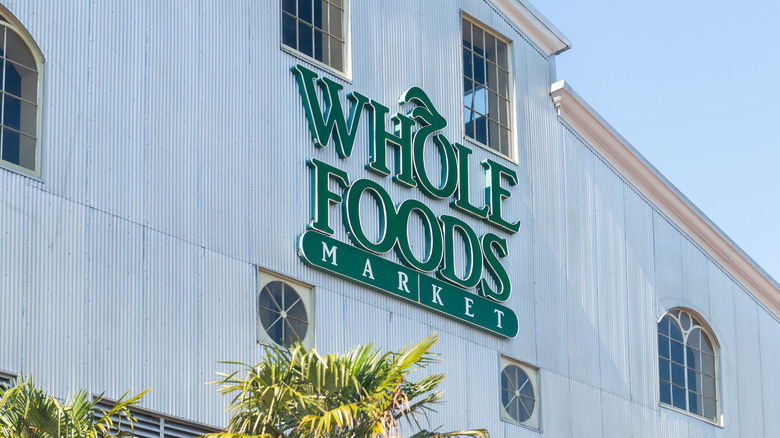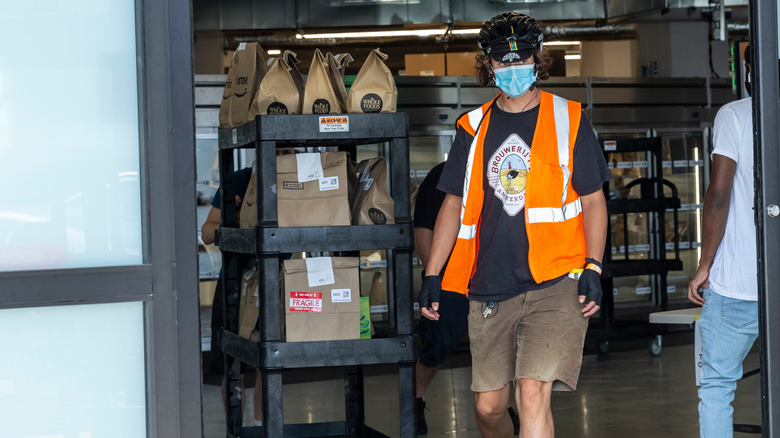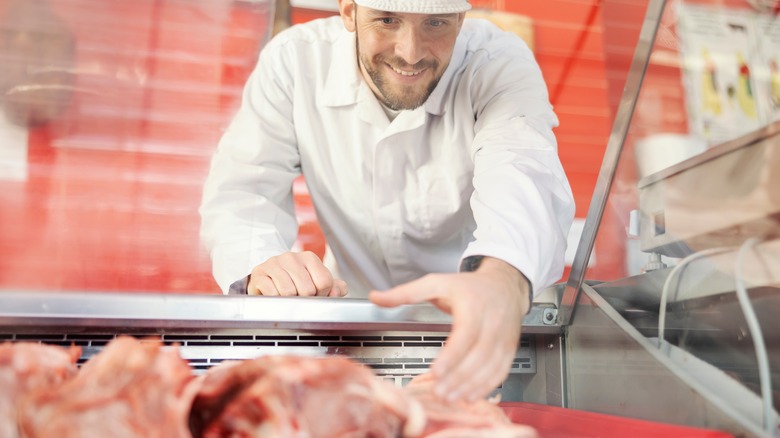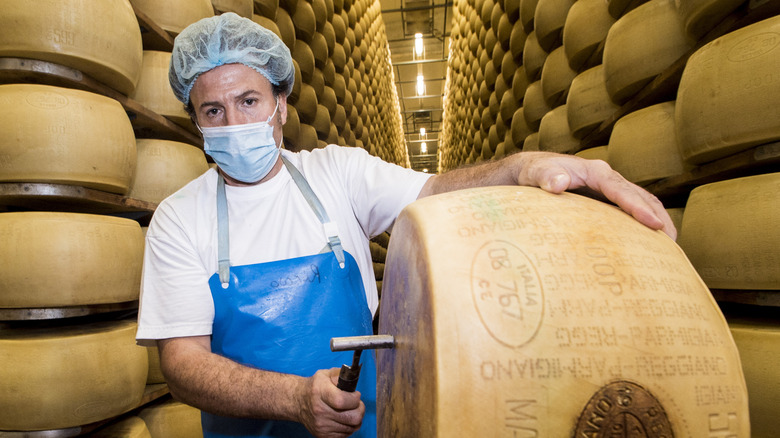The Untold Truth Of Whole Foods
We may receive a commission on purchases made from links.
Whole Foods is the divisive upscale market you either love or hate. While fans praise the store's commitment to natural and organic foods — their trademarked slogan is "America's Healthiest Grocery Store," after all — others have dubbed it "Whole Paycheck" for their exorbitant prices. And come on, even the biggest Whole Foods enthusiasts would have to admit that a store selling individual peeled oranges for $6 has gone a bit too far... but more on that later.
The chain has come a long way since opening its first small store in Austin, Texas in 1980, and now has almost 500 locations throughout North America and the United Kingdom. Over the last four decades, Whole Foods has made plenty of headlines — most notably due to the 2017 acquisition by Amazon in August 2017 for a whopping $13.7 billion. But what about the scandals, the products that have caused social media uproar, or the odd company policy concerning employees' BMIs? What truth is lurking under all that quinoa and organic produce? Let's find out.
Does it deserve its Whole Paycheck nickname?
When you see evidence like this receipt, it's hard to say that Whole Foods shouldn't be named Whole Paycheck — $24 for 12 ounces of almond butter does seem a bit extreme. But does the store really deserve its unflattering moniker?
In 2016, prior to the Amazon acquisition, Wedbush Securities compared Whole Foods to stores like Safeway, Kroger, and Wegmans, and found them to be about 15 percent more expensive than "conventional supermarkets." When compared to "specialty grocers," like Sprouts and Trader Joe's, Whole Foods was found to be about 19 percent more expensive. However, the biggest hits to shoppers came in the meat and produce departments, where prices were 40 and 22 percent more, respectively, than that of competitors.
But what about all those big price cuts Amazon made after the acquisition? Although some items saw cuts by as much as 43 percent, Reuters reported that an analysis showed just a 1.2 percent overall decrease in prices. In other words, unless you know exactly which products to buy, Whole Foods is still pretty expensive, and won't be shedding that nickname anytime soon.
Just how expensive is it compared to Trader Joe's?
Trader Joe's is known for its cheap groceries, and most die-hard fans would rather drive 20 miles out of their way than set foot in a Whole Foods, but how do the two stores compare after the Amazon-driven price cuts? CNBC went on a reconnaissance mission in Manhattan to find out, and the results might make you rethink your anti-Whole Foods stance.
Ten comparable items were purchased at each store: bananas, organic baby kale, avocados, almond butter, sliced turkey breast, cage-free eggs, butter, ice cream, whole almonds, and milk. At Whole Foods, the total tab came to $41.45, while Trader Joe's rang up at $37.15 — a difference of only $4.30. Yes, most items at Whole Foods were marginally more expensive than Trader Joe's, but surprisingly, none of the products were more than $1 higher, and the milk, eggs, and avocados cost the same at both stores.
Bottom line? Depending on what you're shopping for, maybe that 20 mile drive isn't worth it after all.
The overcharging scandal
One thing Whole Foods doesn't need to do is give haters more ammunition when comes to the store's high prices, but an overcharging scandal in 2015 gave them just that.
An investigation of New York City's Whole Foods stores, led by the Department of Consumer Affairs, revealed a "systematic overcharging for pre-packaged foods." The DCA found that of 80 foods priced by the pound, none were labelled with the correct weight, and of those, 89 percent "violated federal rules for how much a package can deviate from actual weight."
Julie Menin, the department's commissioner, told CNN, "Our inspectors tell me this is the worst case of mislabeling they have seen in their careers." Everything from coconut shrimp to berries to chicken tenders was affected, with the amount of overage ranging from an easy-to-miss 80 cents all the way up to a jaw-dropping $14.84. If you were lucky, you might happen to purchase one of the very few packages that was actually underweight.
Whole Foods denied the allegations, but ultimately agreed to pay a $500,000 settlement, as well as implement new policies and conduct quarterly audits of the weights of their pre-packaged foods.
The most laughable product fails
Say what you will about $32 per pound dried blueberries and $111 heritage turkeys — nothing will ever come close to being as ridiculous as these two Whole Foods fails.
It started with an Instagram post captioned, "Somewhere in L.A., Whole Foods executives are laughing at all of us." The image? A bottle of water infused with three asparagus spears, and wait for it... priced at $5.99. The now-infamous asparagus water quickly went viral, and Whole Foods quickly walked it back, telling CBS News, "We actually don't sell asparagus water in our stores... It was meant to be water with the essence of vegetables and/or mushrooms (similar to bone broth), which is typically made over a long period of time soaking in water. It was made incorrectly and has since been removed."
Less than a year later, another product had social media frothing at the mouth. This time? A single pre-peeled orange, nestled it its own plastic container, selling for — you guessed it — $5.99. "If only nature would find a way to cover these oranges so we didn't need to waste so much plastic on them," one Twitter user lamented. Again the store quickly responded, saying, "These have been pulled. We hear you, and we will leave them in their natural packaging: the peel." And presumably they will be priced at less than $6.
What their list of banned ingredients would mean at Walmart
It's hard to doubt Whole Foods' commitment to retaining their title of "America's Healthiest Grocery Store" when you take a glance at their list of banned ingredients. According to their website, the 79 items (as of September 2018) represent all the "ingredients that we find unacceptable in food. In other words, we won't sell a food product if it contains any of these." The most common offenders are included — artificial color and flavor, preservatives, and of course everyone's arch nemesis, high fructose corn syrup — along with an array of hard-to-pronounce chemicals. Sure, it's an impressive list, but what does it mean in the real world?
Based on an analysis of Walmart's products in 2014, Slate determined that 14 percent of the big box store's products wouldn't make the cut at Whole Foods due to their inclusion of high fructose corn syrup alone. Once you take the rest of the ingredients into account, a shocking 54 percent of Walmart's products are off the table.
Basically, if you're heading into Whole Foods to satisfy your Oreo craving, you're out of luck — but there's probably a natural and organic substitute, if you're into that kind of thing.
The hot bar can be a total rip-off
The Whole Foods hot bar seems like a great idea — the food always looks fresh and well-prepared, it's super convenient, and a few scoops of mashed potatoes isn't going to break the bank, right? Wrong. PopSugar writer Anna Monette Roberts found out the hard way that a few scoops of mashed potatoes can run you a mind-blowing $14, for what amounts to about one-and-a-half pounds of buttery spuds that could be made at home for pennies on the dollar.
How can that possibly be? Well, everything at the hot bar is $8.99 a pound, whether it's meat, greens, or grains, and, spoiler alert, potatoes are dense. When Roberts questioned the exorbitant amount, the cashier chuckled and told her, "There's no mistake. The hot bar is the 'Whole' in 'Whole Paycheck,' hon." Ouch.
If you just can't quit the hot bar, keep these smart money-saving tips in mind: Avoid bone-in meats — you're paying for all that weight of something you don't even get to eat; choose leafy greens, like arugula and spring mix, over heavier lettuce like romaine; and please, we beg you, skip the sides that you could easily make at home. Basics like rice, mashed potatoes, and steamed veggies are just not worth it at that price.
The CEO's salary will shock you
In November 2006, Whole Foods CEO John Mackey wrote a letter to his employees regarding a decision he had made about his own salary. No, he wasn't giving himself a raise — he was taking a big pay cut.
The letter read, in part, "The tremendous success of Whole Foods Market has provided me with far more money than I ever dreamed I'd have and far more than is necessary for either my financial security or personal happiness... I have reached a place in my life where I no longer want to work for money, but simply for the joy of the work itself and to better answer the call to service that I feel so clearly in my own heart. Beginning on January 1, 2007, my salary will be reduced to $1, and I will no longer take any other cash compensation..."
Selfless as that may seem, Mackey did end up with almost 1 million shares of stock, and therefore pocketed $8 million as a result of the Amazon acquisition. Clearly that 10 years worth of work for $10 didn't hit him too hard, as he is reportedly worth more than $75 million.
The weird BMI-based employee discount
Employee discounts are one of the nice perks that come with working retail, but how would you feel if that discount was tied to your body mass index (BMI)? That's a reality for Whole Foods team members.
In 2010, a letter to employees from CEO John Mackey revealed the company's new Team Member Healthy Discount Incentive Program, in which they could qualify for up to a 30 percent discount (instead of the regular 20 percent) if their BMI, blood pressure, and cholesterol were low enough, and if they were also a non-nicotine user. All this is determined by bi-annual blood work and heath checks, and the discount is reassessed if any of those slip, but Mackey goes on to say that this program should be "empowering and fun for Team Members who enjoy a challenge." Empowering is probably the last word we'd choose to describe this cringe-worthy "incentive" that actually benefits the company by lowering its health care costs, but at least the program is voluntary.
Employee secrets you need to know
When you want all the juicy gossip and company secrets, where do you turn? The in-store employees, of course. Here are some lesser known shopping tips one former Whole Foods team member wants you to know.
- Try before you buy: You can sample anything in the store, including "prepared foods, packaged grocery items, and body care." You can even get fresh fruit cut open in the product department.
- This money-saving secret has the potential to save you big bucks: Be on the lookout for sale signs that expired the day before. "Go to the store early in the morning the day after the sale has ended, and the sale tag may still be up, the former employee dishes. "If that item rings up at a different price than what's marked on the tag, it's free!"
- Don't get stuck buying a huge piece of cheese you won't finish: Any piece at the cheese counter can be recut into a smaller portion.
- One last tip: Keep an eye on the size of the dishes in the hot bar. "When a dish is in a larger pan, that means it's fresher. Food gets transferred to smaller pans as it dwindles."
The rabbit meat scandal
Whole Foods, known for their high standards when it comes to animal welfare, ruffled feathers with their decision to sell rabbit meat in 2014. The move prompted protests and an online petition that garnered almost 60,000 signatures, due to that fact that, although the company touted its rigorous rabbit welfare standards, those standards just aren't rigorous enough. According to Rabbit.org, "Because rabbits are not covered under the USDA's Humane Methods of Slaughter Act, they (like poultry) don't have to be stunned like other animals classified as livestock before they are slaughtered..." which can result in a painful death — seemingly the very opposite of what Whole Foods stands for.
Ultimately, an NBC Bay Area investigation into USDA inspection reports revealed violations, including a violation of Whole Foods' own "no crate" rule, and the decision was made to stop selling rabbit meat. Although the company blamed poor sales for the about-face, Marcy Schaaff, founder of SaveABunny rabbit rescue pointed to a different reason: "Ultimately, NBC exposed they were not following humane standards and they were in violations in food safety. We're thrilled that Whole Foods has decided to stop the sale of rabbit meat."
Before there was Whole Foods, there was Safer Way
Not to be confused with Safeway, Safer Way was the health food market that former Whole Foods CEO John Mackey first founded in Austin, Texas, in 1978 (via Business Insider). The story of Safer Way is proof that even super successful grocery store CEOs sometimes fail, as Safer Way was far from a hit. Mackey and his co-founders were really into eating healthy, which meant Safer Way didn't sell any kind of meat, food with refined sugar, or even (gasp) coffee. Needless to say, they weren't the most popular shop on the block.
Eventually, Mackey and his business partners pivoted. In his 2020 book "Conscious Leadership," Mackey writes, "We stopped trying to remake the market and started trying to engage the market" (via Business Insider). They merged Safer Way with another smaller grocery store and opened the first Whole Foods Market in Austin in 1980. And if you're wondering, yes, they did indeed sell coffee, sugar, and even beer and wine, while still honoring their health-driven mission of selling natural and organic foods. Apparently, you can have your organic, coconut-sugar-made cake and eat it, too.
Whole Foods acquired a number of smaller grocery stores over the years
Whole Foods Market went from a small, hippie-dippie health food market in Austin, Texas, to an international chain that was purchased by Amazon for $13.7 billion in 2017 (via Business Insider). How did one small market morph into the global behemoth it is today? Whole Foods has always taken the slow-and-steady-wins-the-race approach by buying up or merging with smaller grocery stores over the years. In fact, Whole Foods first came into existence when the founders merged their first store, Safer Way, with Clarksville Natural Grocery. And then starting in 1984, they began expanding throughout Texas, from Dallas to Houston (via Whole Foods).
Whole Foods first expanded outside of Texas in 1988 to New Orleans with the purchase of the Louisiana-based Whole Food Company. In 1993 Whole Foods expanded to Southern California by buying Mrs. Gooch's, a small chain health food store. In 2013 it bought the Boston-based chain Johnnies Foodmaster and turned a Brookline, Massachusetts, location into the smallest Whole Foods in the country (via Supermarket News). Clearly, its policy of buying smaller groceries has worked for this health-food giant.
Whole Foods has a 'dark store' in Brooklyn
Thanks to the pandemic, people have grown accustomed to having, well, everything from meals to cocktails to groceries delivered to their door. And in a place like New York City where very few residents own cars, the need for grocery delivery is even greater. In fact, Amazon saw online grocery sales triple in the second quarter of 2020 (via Supermarket News). That's why Whole Foods launched a delivery-only store in Brooklyn in September 2020 to help service this growing need without overwhelming its established stores (via Supermarket News).
The huge "dark store" is situated in the Industry City neighborhood of Brooklyn and services the entire borough. Having a store dedicated just to delivery means workers are able to prepare orders quickly and efficiently. But even if you don't live in Brooklyn, Amazon Prime members get free two-hour delivery of Whole Foods groceries in over 2,000 cities across the country.
Whole Foods butchers have to apprentice
Whole Foods might be a giant, massive chain owned by an even larger corporation, but the company is still sticking to its roots by valuing healthy, high-quality, and well-sourced food. That's where its butcher apprenticeship program comes in. Launched in 2013, this year-plus program is designed to teach aspiring butchers the art of the meat (via Meat and Poultry Online). Apprentices learn important culinary skills like preparing different cuts of meat, ensuring quality control, and even cooking tips that they can pass on to customers.
When you enroll in the butcher program, you're really both an apprentice and an employee, as apprentices are expected to perform butchering, serve customers, and learn opening and closing duties as well as take meat-cutting exams and do customer-service exercises (via LinkedIn). For those interested in applying to be a Whole Foods butcher apprentice, it's a full-time position that pays roughly $34,000-$43,000 a year (via Glassdoor).
Whole Foods once held a Guinness World Record
You already know that Whole Foods is the best place to go to find some organic (and sometimes pricey) produce, but you might not know that it also used to hold a Guinness World Record. Its claim to fame? Most Parmigiano-Reggiano Wheels Cracked Simultaneously (via Whole Foods). The grocery chain first created this world record category in 2008 with nearly 300 wheels cracked but says it lost the title four years later to Canadian food retailer Loblaws. In 2013, Whole Foods made cheesemonger history again by hosting an event called "Crack Heard Round the World" in which 426 giant wheels of Parmigiano Reggiano were simultaneously cracked open at Whole Foods locations worldwide (via Miami New Times). Loblaws regained the title the following year, with 1,209 cheese wheels cracked (via Guinness World Records), though Loblaws reported that year it set the record with 1,008 cheese wheels (via Canadian Grocer).
Whole Foods takes its Parmigiano seriously and every year sends its cheesemongers to the Parma region of Italy to taste and select the best wheels of this "King of Cheese." Whole Foods said its cheesemongers also displayed how to properly open these 24-month-aged wheels during the 2008 event using five official knives from Italy's Consorzio del Formaggio Parmigiano Reggiano, making this one of the tastiest Guinness World Records in the book.
There was a major flood at the original Whole Foods location
Whole Foods is clearly a wildly successful company, but it almost didn't make it through the first year. On Memorial Day in 1981, Austin, Texas, experienced its worst flood in over 70 years, and the first Whole Foods Market location was almost completely destroyed (via Inc.). Former Whole Foods founder John Mackey told Oprah's Super Soul Sunday that the fledgling company had been open for only eight months and didn't have any flood insurance. The store had eight feet of water, and all of its products were destroyed. Mackey thought they were doomed ... until employees and devoted customers showed up with mops, shovels, and buckets to help bail the store out.
Over the coming weeks, the Whole Foods workers and loyal customers saved the store, restoring it to its former glory and saving it from bankruptcy and ruin. According to Mackey, when he asked customers why they were willing to help, they told him things like, "Whole Foods is really important to me. I'm not sure I would even want to live in Austin if Whole Foods wasn't here." Needless to say, the multibillion-dollar company would not be here were it not for the passion of those early Whole Foods loyalists.
You can go ice skating at Whole Foods' Austin location
At Whole Foods you can get cheesemonger-approved imported cheeses, grass-fed beef cut by butcher apprentices, wine, beer, and every sort of organic produce you can imagine. And at one location, you can even go ice skating! That's right, the flagship Whole Foods Market location in Austin, Texas, boasts a rooftop ice skating rink during the winter holiday season (via AustinTexas.org). You can have a festive skate on real ice, then pop down below to get your weekly grocery shopping done.
The skating rink was closed for the last few seasons due to the pandemic, but in previous years the rink was open daily from 10 a.m. to 10 p.m. through the end of January (via The Austinot). While one Redditor did caution that the rink is a bit small, here's hoping the rink will reopen for the 2022 season for holiday grocery shoppers to enjoy.
